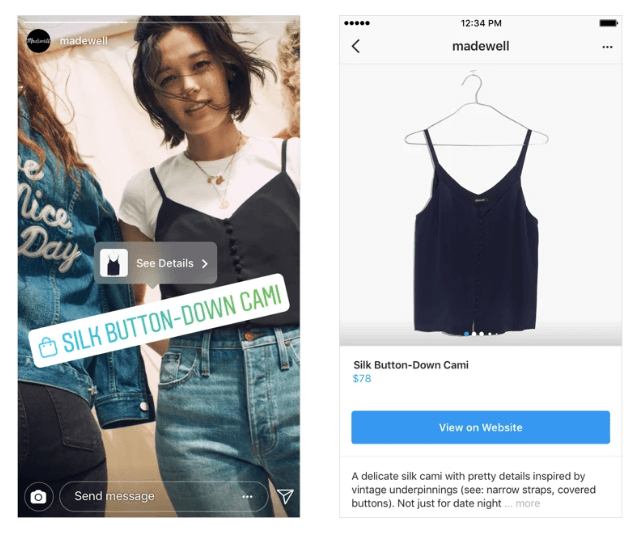“The pandemic pushed more shoppers online to buy gifts over the holidays in 2020, resulting in higher-than-ever online sales growth and penetration: U.S. shoppers spent $201.32 billion online during the holiday shopping season last year, a 45.2% year-over-year increase,” Digital Commerce 360 estimates.
With lockdowns ending and vaccines rolling out, it’s safe to say that gift consumers will continue to shop more in the 2021 holiday season, both in-store and online. Tina Donati, a content marketer with a niche in eCommerce and related B2B and SaaS companies, even emphasizes that “people are eager to get back to the in-store shopping experience where they can have instant gratification with purchasing items and taking them home immediately. Last year, the only option was to shop online. This year, consumers have access to both the online and physical space, so we’ll see more purchases happening in brick-and-mortar locations compared to last year.”
So, the opportunities to drive more sales for brands in the upcoming holiday season are huge, right? But that’s just one side of the equation — another key to success is understanding what gift consumers want and expect to get this year.
If you’re looking for the answer to that question, we’ve got you covered. In this article, we’ll explain four trends in gift consumers’ behaviors you should keep in mind to create a sure-fire 2021 holiday marketing plan.
1. Gift Consumers Use Social Media for Holiday Gift Ideas
In a 2019 survey on what inspires members of Generation Z during the holiday season, National Retail Federation (NRF) discovered that 46% of Gen Zers looked to social media for gift inspiration. Instagram was the top source, followed by YouTube, Pinterest, Snapchat, and Facebook.
In another survey for the 2020 holiday season, Deloitte found that 31% of consumers say social media could trigger a gift purchase. This is aligned with Kantar and Catalyst’s State of Ecommerce 2021, saying shoppers tend to use social media platforms more for discovery and inspiration.
If that doesn’t convince you, check out the Digital 2021 April Statshot report conducted by Hootsuite and We Are Social. The report shows that by April this year, the global total of social media users across platforms reached 4.33 billion. More interestingly, when asked why using social media, 27.8% of respondents said they wanted to find inspiration for things to do and buy; 26.5% said they look for products to purchase.

Hence, it’s in your best interest to take advantage of social media to promote gifts and products and drive more purchases. Consider the following tips:
- Use Instagram Story and Highlights to feature gift ideas to help customers find what they’re looking for.
- Use Instagram Shopping to promote gift products you’re selling.
- Use Reels, TikTok, YouTube, etc., to share gift advice with your followers.
- Include the link to your gift finder or gift guide, or gift cards in your social media bio.
- Include hashtags with gifts (e.g., #christmasgiftsformom, #thanksgivinggifts) in your social media posts to increase the chance of your posts being found by new audiences.
- Run social media ads targeting those who are interested in holiday gifts and gift ideas.
- Make your gift wraps or packages attractive. Encourage purchased customers to share their gift orders on social media. In doing that, you’ll collect valuable user-generated content for future marketing campaigns.
2. Gift Consumers Prioritize Convenience
According to Stephen Smythe, head of EU marketing at Square, the Covid-19 pandemic accelerated not only eCommerce and omnichannel shopping but also “greater expectations from consumers of more convenient services such as click and collect, free delivery and returns and a wider range of products and payment options provided by merchants.” Kantar and Catalyst’s 2020 study also revealed that 66% of shoppers chose a retailer based on convenience, while only 47% chose a retailer based on price or value.
When it comes to convenience, it no longer just means multiple delivery options or faster shipping. Today’s busy consumers also expect and embrace convenience in every other part of their shopping experience — no matter if they shop at a physical store or online.
Here are some tips for using convenience to win more customers:
- Optimize site search experience with a search bar, facets and filters, voice search, category pages, visual product configurators, product recommendations, bundles, product finders, and post-purchase support.
- Use semantics to derive meaning from incomplete and unstructured customer data. Then, use the insights to improve findability within site search.
- Offer multiple delivery options like free shipping, same-day delivery, click and collect, curbside, free return, etc. Also, consider delivering gifts directly to recipients.
- Promote your holiday gifts across channels to reach out to more customers. Meet your customers where they are at the right time in the right place.
- Provide seamless omnichannel experience. Stephen explains that brands should “make it easy for their customers to buy from them online, from their mobile devices or in-store, including click and collect. To do this and provide a seamless experience, businesses should look to implement technologies that are now widely available (such as Square) to enable both online and offline sales and, importantly, also sync their backend systems to have a clear view of their inventory, product availability and sales data.”
3. Gift Consumers Expect Personalized Gifts
In Inviqa’s 2020 survey on gifting, when asked the biggest contributing factor to pick the perfect gift, 85% of respondents said it’s gift suitability — the suitability between gifts and gift receivers.
On the eCommerce site, which features shops of handmade goods, crafts, and other unique items, there’s been a 156% increase in searches for custom or personalized gifts in the past three months compared to the same time a year ago, CNBC reported.
The personalized gift item market was valued at around $31.63 billion in 2020. When offering personalized gifts, it means you allow customers to include gift receivers’ names, write their own messages, send a gift video, or choose wrap sheets they like. In doing so, you help customers design the perfect gifts for their loved ones, making them appreciate your business and stick with you forever.
Try several ways to collect customer data so that you can understand what your target audience wants to create personalized gifts.
Tina suggests brands should “collect emails and phone numbers through pop-ups, gather important data on your customers and their preferences (specifically, zero-party data) through quizzes or surveys, or offer a loyalty program to start engaging customers with gamification techniques.”
She also adds that as digital giants can customize pages and experiences based on every customer’s past purchases and known data, new and growing brands should collect data about customers to start personalizing shopping experiences. “From segmenting emails that recommend products related to each customer’s tastes and preferences to targeting ads to a very specific group, you’ll have much more success capturing the eyes of customers during the holiday season if you’re offering experiences, content, messaging, and discounts that are actually related to their interests and needs,” she states.
4. Gift Consumers Demand Gifts With Meaning
Google’s gifting in the pandemic survey found that “gifting in 2020 grew beyond just an act of love on special occasions to one of empathy and a way to bridge the physical distance caused by quarantine”. It’s because “people witnessed others in their community and around the world suffer through difficult times, they felt compelled to do something about it.”
Etsy’s 2020 Christmas trend report emphasized that shoppers were increasingly looking for thoughtful gifts to show they care from distance. This is reinforced in a new study from De Beers, showing that “56% of people believe gifts should be meaningful, over and above “practical,” “functional” or “fun […] Above all, the primary reason for giving diamond jewelry this holiday season reflects a sense of gratitude and acknowledgment for partners and mothers during the recent crisis, with male respondents stating, “it would send her a message that she’s important and valued.”
Consumer psychologist Chris Gray, Psy.D. of Buycology, said with Forbes’ Pamela N. Danziger that “gifting is not just about expressing care for another person, but there is a lot of identity wrapped up in what someone gives to another person. It says something about you, that you are a thoughtful and caring person.”
Tips for offering gifts with meanings:
- Provide gifts in different categories like work from home gifts, wellness gifts, self-care gifts, environment-friendly gifts, gift vouchers, etc.
- Provide choice to gift recipients. Jenise Steverding, chief impact officer at Gifts for Good, shares that their gifting software “has become incredibly popular because [they] are able to brand the digital experience, and the gift recipient picks out the gift they like the most or is able to gift-it-forward by turning it into a donation for a cause they care about.”
- Don’t compromise on gift quality. “Brands should emphasize the quality of their products in 2021. Customer spending is up and we are seeing a movement towards clients being most interested in purchasing quality products over price sensitivity,” Jenise adds.
Put These Insights Into Action
Now that you’ve understood what gift consumers expect to get in the 2021 holiday season. Use the insights above to develop an effective holiday marketing plan that helps deliver value to your target customers, enhances their shopping experience, and achieves your business goals.
In case you need support with digital experience optimization, contact our expert team today, and we’ll show you how you can do that.

